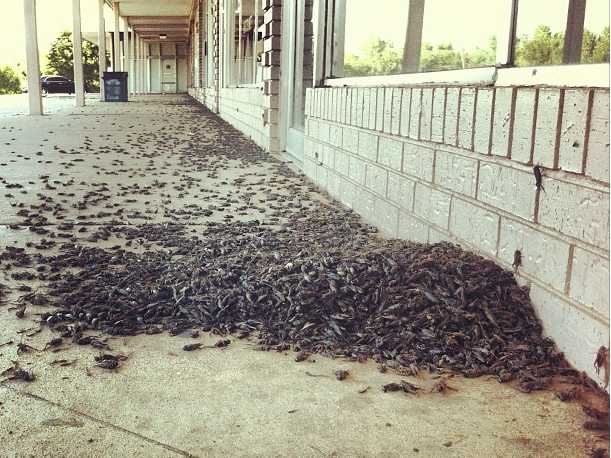
Clay Milford, Staff Writer
During the months of August and September of 2013, the state of Oklahoma underwent a cricket attack of Biblical proportions. After a mild winter and an uncommonly wet spring and summer, Oklahoma has been plagued with hordes of the insect from the central to northeastern parts of the state.
Dr. Rick Grantham, an Entomologist from Oklahoma State University, says that due to the weather, the Sooner state has made itself a perfect cricket breeding ground. “We have crickets at this time every year, but some years we have more than others. Last year we had a large mating flight and this year appears to be another heavy year – actually the first time I have ever seen back-to-back years. A hot summer followed by decent rain in late July and August seems to be the triggers for cricket flight activity. Crickets need warm moist soil to lay their eggs in, and the conditions have been good for the last two years. Nature has a way of controlling how large the populations will be through winter temperatures, moisture, predation, parasitism and cannibalism. If any of these factors have huge swings, then populations will vary greatly.”
Although the swarm has been heavy for the past few months, Dr. Grantham says that we are now at a lull in cricket mating activity. “The peak mating flights were about three weeks ago and numbers have been falling steadily since. We had a little bump in the road about a week ago, but numbers are now falling again. You will probably continue to see a few crickets until we have cold temperatures or a frost.”
For those that do not enjoy the presence of the fall field cricket, or Gryllus pennsylvanicus, the most common cricket found in Oklahoma according to Grantham, there are ways to keep them away. “Exclusion and light management are the only effective ways to repel. Make sure there are no cracks around doors, make sure you caulk around windows and plug or cover weep holes in bricks. Good light management is by far the most effective control and the most contentious. Crickets are strongly attracted to light and, unless you can turn them off or switch to less bug friendly types (low-pressure sodium vapor lamps or yellow incandescent bug lights), then you are going to have crickets. Also, Be sure to remove any dead crickets that pile up around lights as they will feed on dead bodies as well as their normal plant material.”
Although having a cloud of insects around your home can be a nuisance, Dr. Grantham states that having crickets “attack” is not necessarily the worst thing to experience, as they provide food for birds and other animals that prey on them.
The state of Oklahoma seems to have recovered from their condition of shock after seeing the clouds of incoming crickets charging toward their homes, and Dr. Grantham assures everyone that something like this only happens “once every five to ten years.” So, for those shoveling piles of the dead insect away from the side of their home or school, just know you will all will get to wait at least half a decade before you have to do that again. As for now, relax and know that a cricket plague has come and gone, and we are all still here.